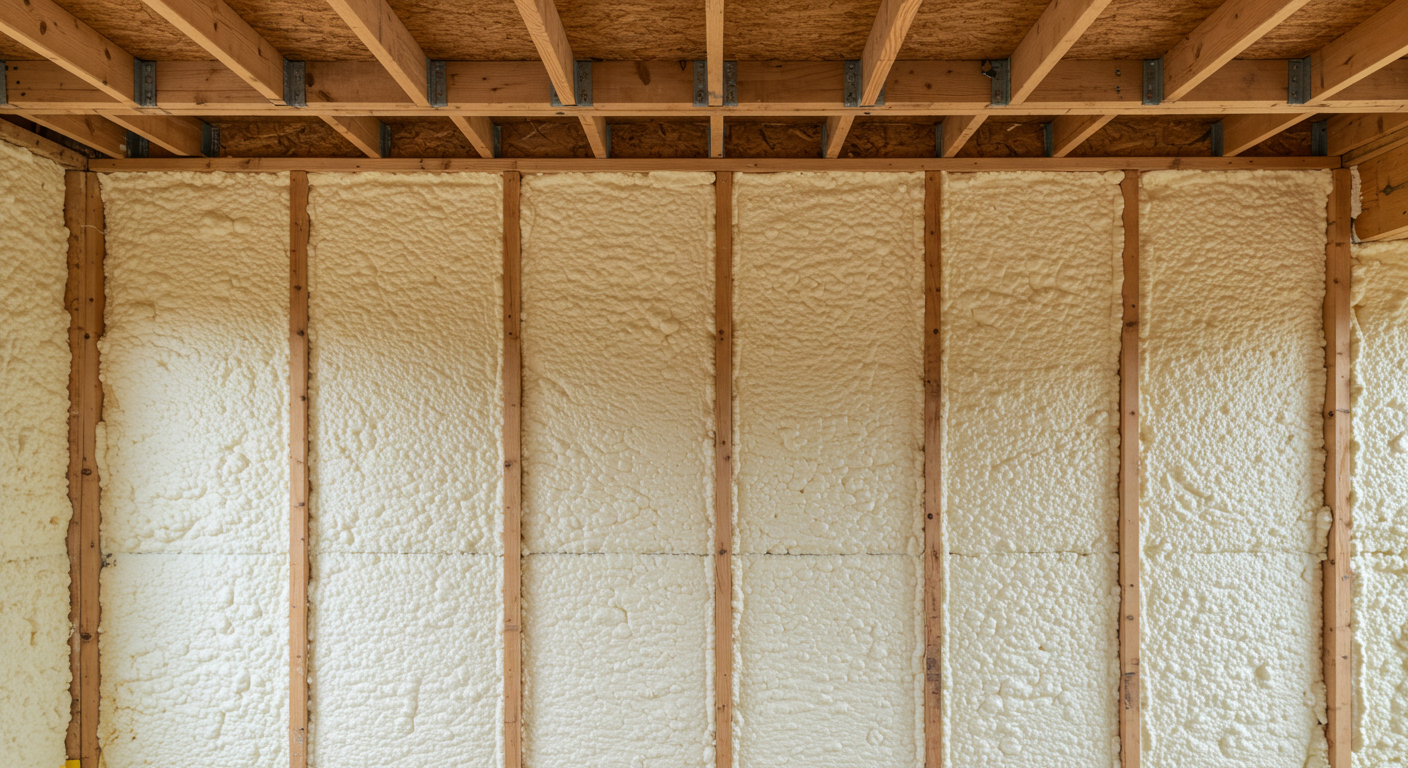At Valley Spray Works, we know exactly why you chose spray foam insulation: long-term performance, year-round comfort, and lower energy bills. But here’s the catch if it isn’t maintained correctly, that investment starts to slip. In Hansen, ID, where temperature swings are real and seasonal shifts take their toll, insulation must stay in peak condition to do its job.
This guide is here to make sure your spray foam insulation keeps delivering everything it promised. We’re sharing what truly works based on years of hands-on experience, real results, and local insight. You’ll walk away knowing exactly how to keep your home running efficiently, prevent costly issues, and decide when it’s time to bring in the pros at Valley Spray Works.
Know What to Look For: Early Signs Matter
Keeping spray foam insulation in Hansen, ID efficient starts with paying attention. Problems rarely show up overnight, and the first signs often go unnoticed until your utility bill tells the story.
A homeowner in Hansen recently reached out after noticing their heating costs creeping up. On inspection, we found small cracks and gaps where foam had started pulling away from wood framing. It didn’t look dramatic, but that minor air infiltration was costing them every month.
Routine Visual Inspections Make a Real Difference
We recommend inspecting your spray foam at least twice a year once in spring and again before winter. Look for discoloration, cracking, or separation from studs or sheathing. These are often the first clues of thermal drift or moisture intrusion.
If you see dark patches, that could mean moisture is being trapped. Our team uses moisture meters to determine if the foam has been compromised. Catching it early prevents insulation failure and structural problems.
Why Our Clients in Hansen Rely on These Seasonal Checkups
Temperature fluctuations in southern Idaho mean expansion and contraction. That seasonal stress can cause spray foam to shrink or pull away slightly especially if the original installation didn’t account for local building movement. Our inspections are geared toward detecting these subtleties and addressing them before they become real issues.
Stop Air Leaks Before They Start Wasting Money
Spray foam is known for its air-sealing ability, but even the best insulation can degrade over time. The air barrier may lose integrity if the foam has been tampered with during renovations or exposed to pests or moisture.
A customer we worked with near downtown Hansen discovered that a rodent had tunneled through a portion of their attic insulation compromising a key thermal barrier. We patched and resealed the area quickly, but the incident highlighted just how vulnerable spray foam can be when left unchecked.
Checking for Drafts and Thermal Leaks
Run your hand around the edges of windows, crawlspaces, and electrical penetrations. If you feel even the slightest draft, it’s worth having us check for insulation gaps or compression.
Thermal imaging is a service we often perform during maintenance calls. It reveals invisible leaks and weak spots that standard inspection can miss. The result? You regain full control over your indoor climate and energy use.
How Valley Spray Works Keeps the Seal Tight
We don’t just patch leaks we get to the root of why they happened. Maybe a vent pipe was installed after insulation was sprayed. Maybe condensation compromised adhesion. Whatever the cause, our technicians fix it thoroughly and reinforce the area to prevent repeat problems. Our clients appreciate that we don’t offer quick fixes we offer long-term results.
Defend Against Moisture Before It Wrecks Your Insulation
Water is spray foam’s silent enemy. It doesn’t take much moisture to undermine an otherwise perfect installation. And in Hansen, with occasional humidity spikes and the risk of plumbing leaks in tight crawlspaces, moisture exposure is a real concern.
Signs Moisture May Be Getting In
Watch for musty smells, damp drywall, or swelling around baseboards. These could signal water infiltration through compromised insulation. Once foam becomes saturated, its R-value drops, and it loses its ability to resist thermal flow.
In a local home near the canal, we found that a slow plumbing drip had saturated a wall cavity. Mold had started to grow inside the foam. We removed the affected material, corrected the plumbing issue, and re-insulated the cavity properly.
Our Approach to Water-Related Insulation Repairs
Moisture problems don’t scare us—they motivate us. We use closed-cell spray foam for high-risk areas because it resists water better than open-cell. During repairs, we prioritize complete drying and decontamination before reapplying insulation. And yes, we always verify proper air and vapor sealing to prevent a repeat event.
Don’t Let Pests Destroy What’s Protecting You
Pests are another unseen threat to spray foam. Mice, squirrels, and insects can tunnel through insulation, leaving behind a mess of destroyed material and compromised efficiency.
What We’ve Seen Locally
A homeowner south of Hansen had a minor mouse issue—until it turned into a full-blown attic infestation. The rodents had chewed through several feet of spray foam, which we had to completely remove and re-spray. Once the pest problem was handled, we resealed everything using our protective layering techniques.
Preventing Recurrence With the Valley Spray Works Method
We use foam densities and installation techniques that resist pest intrusion better than standard applications. When needed, we recommend exclusion upgrades that make your home a less attractive target. We also seal known access points during any insulation maintenance service.
Know When to Call for Professional Help
Homeowners can catch a lot with a careful eye, but not every problem is visible or easy to fix without the right tools. That’s where we come in.
Advanced Diagnostic Services
From thermal imaging to blower door testing, our diagnostic approach reveals the full picture. If your energy bills are climbing without an obvious cause or if parts of your home feel too hot or cold—there’s likely a hidden insulation issue. We identify and solve it.
Maintenance That Goes Beyond the Surface
A full maintenance visit from Valley Spray Works includes a visual inspection, moisture scan, pest entry check, and structural evaluation of spray foam adhesion. We patch small defects, recommend long-term solutions, and answer every question you have on-site.
Let’s Keep Your Insulation Working as Hard as You Do
We believe spray foam should be a set-it-and-forget-it solution but only if it’s maintained right. For homeowners in Hansen, ID, that means checking for small signs before they become big problems, staying ahead of moisture and pests, and calling us in when things get beyond DIY.
We’ve helped families all over Hansen restore efficiency and comfort with a single maintenance visit. If your insulation isn’t pulling its weight or if you just want peace of mind it’s time to schedule a checkup.
Reach out to Valley Spray Works today. We’ll make sure your insulation does what it was always meant to do: protect your home, your comfort, and your bottom line.
Phone: (208) 490-9260
Email: [email protected]
Still Curious? Valley Spray Works Has You Covered
How often should spray foam insulation be inspected in Hansen, ID?
Twice a year—spring and fall. These seasonal changes reveal problems before they get worse.
Can spray foam go bad over time?
Yes. UV exposure, moisture, pests, or even shifting building structures can degrade spray foam.
What are signs my spray foam isn’t working properly?
Higher energy bills, uneven temperatures, drafts, visible cracking, or discoloration.
Can I repair small damage myself?
You can apply DIY foam for minor touch-ups, but we recommend calling us for anything larger than a few inches.
Is moisture really that big of a deal for spray foam?
Absolutely. Trapped moisture ruins R-value and can lead to mold. It must be addressed quickly.
Does spray foam attract pests?
Not naturally, but rodents and insects may tunnel through it if they find a weak spot or existing entry.
What if part of the insulation has pulled away from the framing?
That’s a sign of movement or adhesion failure. We’ll assess and reapply foam where needed.
Can I walk on spray foam in the attic?
Only if it was installed with load-bearing application in mind. Ask us to verify.
How long does spray foam insulation last if maintained?
With proper care, 20–30 years or more.
What’s included in a maintenance visit from Valley Spray Works?
Visual inspection, leak testing, minor patching, pest check, and expert recommendations.



